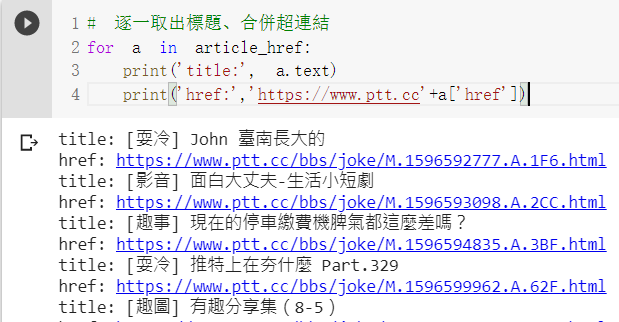
ctrl + Shift + I 或F12 :
目標網址 https://www.ptt.cc/bbs/joke/index.html ,有輸出前500字表示擷取成功。
import requests
from bs4 import BeautifulSoup
res = requests.get('https://www.ptt.cc/bbs/joke/index.html')
soup = BeautifulSoup(res.text ,"lxml")
print(res.text[:500])
接下來如果簡單針對該頁面的連結、標題觀察,發現div 標籤的 class='r-ent' 有可疑的味道:

用 soup.select("div.r-ent")把一個個貼文都抓下來,結果會是個 Python 的串列 list,以逗號區隔,還充斥著網頁標籤的味道:
results = soup.select("div.title")
print(results)

試圖擷取超連結,繼續以 soup.select() 定位所需資訊:
article_href = soup.select("div.title a")
print(article_href)

逐一取出標題、合併超連結:
for a in article_href:
print('title:', a.text)
print('href:','https://www.ptt.cc'+a['href'])

PPT 部分版會詢問是否滿18歲,那就觀察網頁模仿點選滿18歲的送出內容,原來是 requests.get 要加cookies = {'over18': '1'} 參數,整理為會說已滿18的程式如下,如您未滿18歲請據實回答喔:
#需滿18歲要加cookies = {'over18': '1'}
import requests
def PTT_check_over_18(url):
"""
如果被詢問需要大於18歲時,自動點符合
:url 要解析的網址
"""
response = requests.get(url)
response = requests.get(url, cookies={'over18': '1'}) # 一直向 server 回答滿 18 歲了 !
return response
url = 'https://www.ptt.cc/bbs/Gossiping/index.html'
resp = PTT_check_over_18(url)
print(resp.text[:500])
匯率資料來源:https://tw.rter.info/howto_currencyapi.php#
網頁說明:
程式碼:
import requests
r=requests.get('https://tw.rter.info/capi.php')
currency=r.json()
requests.get() 取得的網頁資訊,如果是 JSON 形式如圖:
requests.get().json() 轉為 Python 的字典 dict 資料型態。
Python 的字典 dict 操作相當方便,譬如我要台幣匯率,循字典的樹狀結構的鍵值 keys查詢即可。
usd_to_twd = currency['USDTWD']['Exrate']
usd_to_twd
同理要顯示時間也只需要 currency['USDTWD']['UTC'] 即可。
usd_to_twd() 函數方便日後使用:
import requests
def usd_to_twd():
"""
台幣目前匯率
"""
r=requests.get('https://tw.rter.info/capi.php')
currency=r.json()
usd_to_twd = currency['USDTWD']['Exrate']
currency_time = currency['USDTWD']['UTC']
return f'台幣匯率: {usd_to_twd},更新時間: {currency_time}'
import requests
from bs4 import BeautifulSoup as bs
url = 'https://memes.tw/wtf' # 爬取https://memes.tw/wtf中網友創作的第一張梗圖
img = bs(requests.get(url).text ,"lxml").find_all("", {'class': 'img-fluid'})[0]['data-src']
.find_all("", {'class': 'img-fluid'})[0]['data-src'] 中間的 [0] 改以 for迴圈依序處裡,該頁面有幾張圖都可以取出來,觀察網站發現最多顯示為 20 張圖。memes_hot_imgs() 函數,方便日後取用。
import requests
from bs4 import BeautifulSoup as bs
def memes_hot_imgs(how_many = 1):
"""
可回傳'https://memes.tw/wtf'網友創作熱門迷因圖,
:how_many 參數接受整數1~20,預設=1,即至多回傳20張圖。
"""
url = 'https://memes.tw/wtf'
imgs = bs(requests.get(url).text ,"lxml")
imgs_list = []
if how_many > 20: #每頁至多20張限制
how_many = 20
for img in range(how_many):
_ = imgs.find_all("", {'class': 'img-fluid'})[img]['data-src']
imgs_list.append(_)
return imgs_list
memes_hot_imgs2() 函數,兩者功能相同,您喜歡哪種口味呢?
import requests
from bs4 import BeautifulSoup as bs
def memes_hot_imgs2(how_many = 1):
"""
可回傳'https://memes.tw/wtf'網友創作熱門迷因圖,
:how_many 參數接受整數1~20,預設=1,即至多回傳20張圖。
"""
url = 'https://memes.tw/wtf'
imgs = bs(requests.get(url).text ,"lxml")
imgs_list = []
if how_many > 20: #每頁至多20張限制
how_many = 20
imgs_list = [ imgs.find_all("", {'class': 'img-fluid'})[img]['data-src'] for img in range(how_many)]
return imgs_list
memes_hot_imgs2() 也可以運作。
